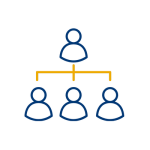The mission of the Division of People, Culture and Belonging is to foster a workplace culture of care and continuous growth through exceptional service and support, where everyone has the opportunity to thrive and belong.
This site is designed to give you the resources required to effectively recruit, hire and manage employees within your department, division or unit. The Management Toolkit combines the resources of several departments, including training and development, benefits, employee relations, communications, affirmative action, talent acquisition, compensation, and outreach.

Beyond Compliance
Beyond Compliance (BC) is an initiative that provides annual training for Kent State faculty and staff. Since 2014, Beyond Compliance ensures that faculty and staff are fully up-to-date and aware of the relevant laws and university policies regarding discrimination, harassment and violence prevention.

Departmental Reorganizations & Name Changes
Kent State University is comprised of multiple campuses and divisions and hundreds of departments across the university system. As a result, it isn’t uncommon for a unit to undertake a name change or reorganization. Because either undertaking is quite complex, this web page will serve as your guide through the process.

EMPLOYEE & LABOR RELATIONS
Employee Relations works with managers and employees to enhance the working environment for Kent State employees. Labor Relations oversees all aspects of labor relations activities for AFSCME-represented employees at Kent State.

EMPLOYEE ASSISTANCE PROGRAM
In life, you face a whole range of everyday issues and questions. While managing your work, personal and family needs can sometimes feel overwhelming. That's why Kent State University provides the Employee Assistance and Work/Life program through IMPACT Solutions.

Forms Library
Visit this page for a curated list of forms and PDFs for a variety of functions and operations including benefits, retirement and separation, flexible work arrangements, leave request and more.

New Hire Onboarding
Explore best practices, onboarding guides, New Hire Orientation schedule and more.

Performance Evaluations
Performance Evaluations are an essential piece of employment at Kent State. Explore best practices and resources, and access your Evaluation account on this page.

Recruiting/Hiring Tools
The hiring of new employees to Kent State University is a critical function in the continued growth of the university. Its success and ultimate impact upon the university makes understanding the hiring process a key function of all university hiring officials, hiring managers, supervisors and the staff that support them in this endeavor.

Transitional Work Program
The goal of the Transitional Work Program is to make every reasonable effort to provide suitable alternative work options or reasonable accommodations for a Kent State employee who is unable to perform his/her regular job duties as the result of a work-related injury or illness.

Workers' Compensation
If you are involved in an accident at work, follow the provided steps to alert the appropriate people and offices.

